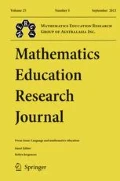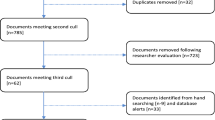Abstract
The characteristics that typify an effective teacher of mathematics and the environments that support effective teaching practices have been a long-term focus of educational research. In this article we report on an aspect of a larger study that investigated ‘best practice’ in mathematics teaching and learning across all Australian states and territories. A case study from one Australian state was developed from data collected via classroom observations and semi-structured interviews with school leaders and teachers and analysed using Valsiner’s zone theory. A finding of the study is that ‘successful’ practice is strongly tied to school context and the cultural practices that have been developed by school leaders and teachers to optimise student learning opportunities. We illustrate such an alignment of school culture and practice through a vignette based on a case of one ‘successful’ school.


Similar content being viewed by others
References
Anthony, G., & Walshaw, M. (2009). Characteristics of effective teaching of mathematics: a view from the west. Journal of Mathematics Teacher Education, 2(2), 147–164.
Appleton, J. J., Christenson, S. L., & Furlong, M. J. (2008). Student engagement with school: critical conceptual and methodological issues of the construct. Psychology in the Schools, 45, 369–386.
Australian Curriculum, Assessment and Reporting Authority (ACARA). (2013). Guide to understanding 2013 Index of Community Socio-educational Advantage values. Downloaded from http://www.acara.edu.au/_resources/Guide_to_understanding_2013_ICSEA_values.pdf.
Australian Academy of Sciences. (2016). The mathematical sciences in Australia: a vision for 2015. Canberra: Australian Academy of Science.
Ball, D. L., Thames, M., & Phelps, G. (2008). Content knowledge for teaching: what makes it special? Journal of Teacher Education, 59(5), 389–407.
Bennison, A. (2015). Supporting teachers to embed numeracy across the curriculum: a sociocultural approach. ZDM - The International Journal on Mathematics Education, 47(4), 561–573.
Blanton, M., Westbrook, S., & Carter, G. (2005). Using Valsiner’s zone theory to interpret teaching practices in mathematics and science classrooms. Journal of Mathematics Teacher Education, 8, 5–33.
Borko, H., Jacobs, J., Eiteljorg, E., & Pittman, M. E. (2009). Video as a tool for fostering productive discussions in mathematics professional development. Teaching and Teacher Education, 24, 417–436.
Bronfenbrenner, U. (1989). Ecological systems theory. In R. Vasta (Ed.), Annals of child development, Vol. 6 (pp. 187–249). Greenwich, CT: JAI Press.
Chapman, E. (2003). Alternative approaches to assessing student engagement rates. Practical Assessment, Research and Evaluation, 8, 13 .http://www.PAREonline.net/getvn.asp?v=8&n=13 (accessed December 12, 2012)
Charalambous, C. Y., Hill, H. C., & Mitchell, R. (2012). Two negatives don’t always make a positive: exploring how limitations in teacher knowledge and the curriculum contribute to instructional quality. Journal of Curriculum Studies, 44(4), 489–513.
Chetty, R., Friedman, J. N., & Rockoff, J. E. (2014). Measuring the impacts of teachers II: evaluating bias in teacher value-added estimates. American Economic Review, 104(9), 2593–2632.
Clarke, D. (2007). Ten key principles from research for the professional development of mathematics teachers. In G. C. Leder & H. J. Forgasz (Eds.), Stepping stones for the 21st century. Australasian mathematics education research (pp. 27–37). Rotterdam: Sense Publishers.
Clarke, M., & Pittaway, S. (2014). Marsh's becoming a teacher (6th ed.). Frenchs Forest: Pearson Australia.
Cobb, P., & Jackson, K. (2011). Towards an empirically grounded theory of action for improving the quality of mathematics teaching at scale. Mathematics Teacher Education and Development, 13(1), 6–33.
Cobb, P., Zhao, Q., & Dean, C. (2009). Conducting design experiments to support teachers’ learning: a reflection from the field. Journal of the Learning Sciences, 18, 165–199.
Confrey, J. (2011). What now? Priorities in implementing the common core state standards for mathematics. In W. H. Schmidt (Ed.), Research in mathematics education: where do we go from here? (pp. 37–48). East Lansing: Michigan State University Institute for Research on Mathematics and Science Education.
Confrey, J., Maloney, A., Nguyen, K., Mojica, G., & Myers, M. (2009). Equipartitioning/splitting as a foundation of rational number reasoning using learning trajectories. Paper presented at the 33rd Conference of the International Group for the Psychology of Mathematics Education, Thessaloniki, Greece.
Danielson, C. (2013). The framework for teacher evaluation instrument. Princeton: The Danielson Group.
Elmore, R. F. (2002). Testing trap. Harvard Magazine, 105(1), 35.
Elmore, R. F. (2006). Leadership as the practice of improvement. Paper presented at the OECD International Conference on Perspectives on Leadership for Systemic Improvement, London.
Fredricks, J. A., Blumenfeld, P. C., & Paris, A. H. (2004). School engagement: potential of the concept, state of the evidence. Review of Educational Research, 74(1), 59–109.
Gibson, J. J. (1966). The senses considered as perceptual systems. Boston: Houghton Mifflin.
Goos, M. (2005). A sociocultural analysis of the development of pre-service and beginning teachers’ pedagogical identities as users of technology. Journal of Mathematics Teacher Education, 8(1), 35–59.
Goos, M. (2007). Developing numeracy in the learning areas (middle years). Adelaide: Keynote address delivered at the South Australian Literacy and Numeracy Expo.
Goos, M. (2013). Sociocultural perspectives in research on and with mathematics teachers: a zone theory approach. ZDM Mathematics Education, 45(4), 521–533.
Goos, M. (2014). Creating opportunities to learn in mathematics education: a sociocultural perspective. Mathematics Educational Research Journal, 26(3), 439–457.
Hattie, J. (2015). The applicability of visible learning to higher education. Scholarship of Teaching and Learning in Psychology, 1(1), 79–91.
Hiebert, J., & Grouws, D. (2007). The effects of classroom mathematics teaching on students’ learning. In F. K. Lester (Ed.), Second handbook of research on mathematics teaching and learning (pp. 371–404). Greenwich: Information Age.
Horn, I. S., & Little, J. W. (2010). Attending to problems of practice: routines and resources for professional learning in teachers’ workplace interactions. American Educational Research Journal, 47(1), 181–217.
Jansen, A., Bartell, T., & Berk, D. (2009). The role of learning goals in building a knowledge base for elementary mathematics teacher education. Elementary School Journal, 109(5), 525–536.
Kazemi, E., & Hubbard, A. (2008). New directions for the design and study of professional development: attending to the coevolution of teachers’ participation across contexts. Journal of Teacher Education, 59, 428–441.
Lawson, M., & Lawson, H. (2013). New conceptual frameworks for student engagement research, policy, and practice. Review of Educational Research, 83, 432–479.
Lerman, S. (1996). Editorial for special issue on. Socio-cultural approaches to mathematics teaching and learning. Educational Studies in Mathematics, 31(1–2), 1–9.
Lerman, S. (2013). Theories in practice: mathematics teaching and mathematics teacher education. ZDM - The International Journal on Mathematics Education, 45(4), 623–631.
Miles, M. B., Huberman, A. M., & Saldana, J. (2014). Qualitative data analysis (2nd ed.). Thousand Oaks: SAGE.
Millett, A., & Bibby, T. (2004). The context for change. In A. Millett, M. Brown, & M. Askew (Eds.), Primary mathematics and the developing professional (pp. 1–17). Dordrecht: Kluwer Academic Publishers.
National Council of Teachers of Mathematics [NCTM]. (2014). Principles to actions: ensuring mathematical success for all. Reston: NCTM.
NSW Department of Education and Training. (2003). Quality teaching in NSW public schools: discussion paper. Sydney: NSW DET.
Oerter, R (1992). The zone for proximal development for learning and teaching. In Oser, F., Dick, A. & Patry, J. (Eds.), Effective and responsible teaching: The new synthesis, (pp. 187–202). San Francisco, Jossey-Bass Publishers.Oesterle, & C. Allan (Eds.), Proceedings of the Joint Meeting of PME 38 and PME-NA 36 (Vol 2, pp. 137–144). Vancouver, Canada: PME.
Office of the Chief Scientist. (2012). Mathematics, engineering and science in the national interest. Canberra: Commonwealth of Australia.
Reschly, A. L., & Christenson, S. L. (2012). Jingle, jangle, and conceptual haziness: evolution and future directions of the engagement construct. In C. Wylie, S. L. Christenson, & A. L. Reschly (Eds.), Handbook of research on student engagement (pp. 3–19). New York: Springer.
Richards, L. (2015). Handling qualitative data: a practical guide. Los Angeles: SAGE.
Schoenfeld, A. H. (2014). What makes for powerful classrooms, and how can we support teachers in creating them? A story of research and practice, productively intertwined. Educational Researcher, 43(8), 404–412.
Simon, M. A. (2009). Amidst multiple theories of learning in mathematics education. Journal for Research in Mathematics Education, 40(5), 477–490.
Sherin, M. G., & Han, S. Y. (2004). Teacher learning in the context of video club. Teaching and Teacher Education, 20, 163–183.
Shulman, L. S. (1986). Those who understand, knowledge growth in teaching. Educational Researcher, 15(2), 4–14.
Stein, M. K., & Kim, G. (2009). The role of mathematics curriculum materials in large-scale urban reform: an analysis of demands and opportunities for teacher learning. In J. T. Remillard, B. Herbel-Eisenmann, & G. Lloyd (Eds.), Mathematics teachers at work: connecting curriculum materials and classroom instruction (pp. 37–55). New York: Routledge.
Stein, M. K., Remillard, J. T., & Smith, M. S. (2007). How curriculum influences student learning. In F. K. Lester (Ed.), Second handbook of research on mathematics teaching and learning (Vol. 1, pp. 319–371). Greenwich, CT: Information Age.
Swars, S., Hart, L. C., Smith, S. Z., Smith, M. E., & Tolar, T. (2007). A longitudinal study of elementary pre-service teachers’ mathematics beliefs and content knowledge. School Science and Mathematics, 107(9), 325–335.
Thomson, S., De Bortoli, L., & Underwood, C. (2016a). PISA 2015: a first look at Australia’s results. Melbourne: Australian Council of Educational Research.
Thomson, S., Wernert, N., O’Grady, E., & Rodrigues, S. (2016b). TIMSS 2015: a first look at Australia’s results. Melbourne: Australian Council of Educational Research.
Timperley, H. (2008). Teacher professional learning and development, Educational Practices Series-18, International Bureau of Education, UNESCO.
Valsiner, J. (1997). Culture and the development of children’s action: a theory of human development (2nd ed.). New York: John Wiley & Sons.
Vygotsky, L. S. (1978). Mind in society. Cambridge: Harvard University Press.
Yoon, K. S., Duncan, T., Lee, C., Scarloss, B., & Shapley, K.L. (2007). Reviewing the evidence on how teacher professional development affects student achievement. Issues & Answers Report, REL 2007–No. 033. Washington, DC, U.S. Department of Education, Institute of Education Sciences, National Center for Education Evaluation and Regional Assistance, Regional Educational Laboratory Southwest.
Young-Loveridge, J., & Mills, J. (2009). Teaching multi-digit multiplication using array-based materials. In R. Hunter, B. Bicknell, & T. Burgess (Eds.), Crossing divides. Proceedings of the 32nd annual conference of the Mathematics Education Research Group of Australasia (pp. 635–643). Palmerston North, NZ: MERGA.
Watson, J., Beswick, K., & Brown, N. (2012). Educational research and professional learning in changing times: the MARBLE experience. Rotterdam: Sense Publishers.
Zambo, R., & Zambo, D. (2008). The impact of professional development in mathematics on teachers’ individual and collective efficacy: the stigma of underperforming. Teacher Education Quarterly, 35(1), 159–168.
Author information
Authors and Affiliations
Corresponding author
Rights and permissions
About this article
Cite this article
Geiger, V., Anderson, J. & Hurrell, D. A case study of effective practice in mathematics teaching and learning informed by Valsiner’s zone theory. Math Ed Res J 29, 143–161 (2017). https://doi.org/10.1007/s13394-017-0191-9
Received:
Revised:
Accepted:
Published:
Issue Date:
DOI: https://doi.org/10.1007/s13394-017-0191-9




